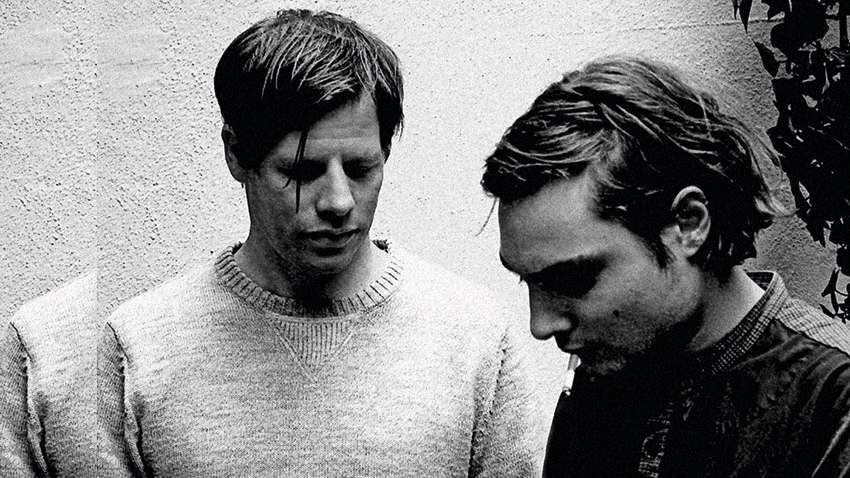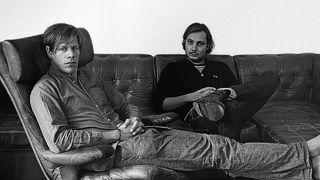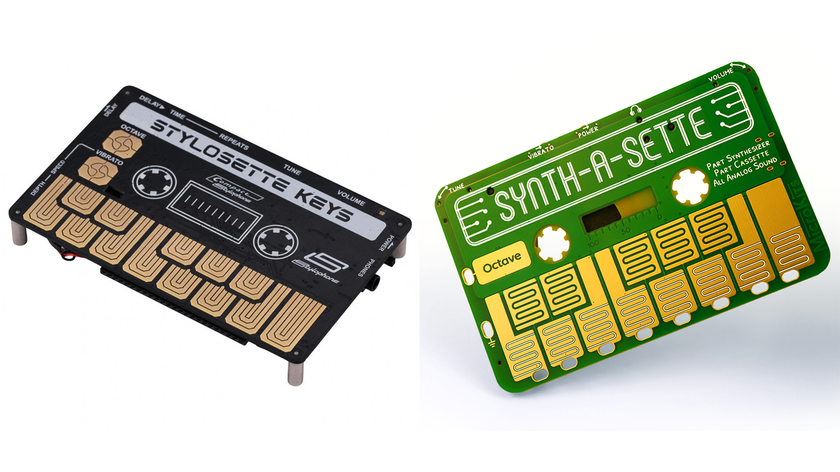Vermont on why hard is better than soft, and how their partnership contrasts with their solo projects
German electronic luminaries reconvene to produce the sumptuous downtempo analogue delights of Vermont II

They’re perhaps better known for their respective DJ/production skills and projects - Marcus Worgull for a slew of floor-fillers on the Innervisions imprint, and Danilo Plessow for the funk-fuelled house of his Motor City Drum Ensemble alter-ego - but when the two halves of Vermont come together, the tempos drop, the vintage synths are dusted down, and mesmeric sound reveries are duly fashioned.
Their debut album, Vermont, landed to much acclaim in 2014, and Plessow and Worgull enjoyed the experience of collaborating enough to crack on with the follow-up, Vermont II. From the languid opening refrain of Norderney, to the analogue arpeggios and lush string synths of standouts Chemtrails and Ufer, Vermont II is a 5am triumph of an album, with its echoes of Tangerine Dream and the kosmische music of the early German synth pioneers.
MusicRadar got the chance to talk tech with Marcus Worgull and Danilo Plessow, and find out a little more about how Vermont II came into being.
Your debut collaboration, Vermont, was written and recorded in Danilo’s Cologne studio; is that where Vermont II was created?
Danilo: “No, actually I moved to Amsterdam, so this album was done in my studio there. Not everything but I’d say maybe 80% of the equipment was the same. The whole concept behind Vermont is that we collaborate in person, where we can share an environment and a mindset.”
Do you have set roles or is it a case of each of you doing whatever's required on any given track?
Marcus: “We don’t have a specific plan or anything… we just meet, start and share. We always seem to quite quickly find the mood that we like, and that’s how we continue. Most of the tracks are done fairly quickly, with simple melodies and without over-thinking things.”
Get the MusicRadar Newsletter
Want all the hottest music and gear news, reviews, deals, features and more, direct to your inbox? Sign up here.
Vermont II is a feast of vintage electronics, but there’s also a real sense of ‘less is more’, and breathing space, in amidst the music. Was that a conscious decision?
Marcus: “Not a conscious thing - as I said, we go with the flow and how it feels. If it feels good then we go with it. We don’t have any special concepts or anything behind it. We go with the things that feel good and that we like; that’s it, really.”
Danilo: “It’s very liberating from our own respective projects, as there’s no pressure, no preconceptions or expectations, such as I might have with a Motor City Drum Ensemble project, where I’m constantly over-thinking: ‘is this the right way to do it?’, ‘Should I use a different sound?’ - things like that. Vermont is born more out of the moment and very spontaneous, which makes
it very satisfying in that regard. It feels like a vacation for me.”
Is Vermont a democracy in the studio?
Danilo: “It’s very much a democracy, although the one thing I would say is that Marcus is maybe more responsible for the initial chord structures or the melodic foundations of the tracks, which I then work around playing the Fender Rhodes or soloing. It’s not always like that, but I’d say maybe 60/40 it is.”
You’re both more known for filling club dancefloors; is Vermont your attempt to corner the after-club market too?
Marcus: “[Laughs] Maybe! That would be a good idea. It’s very contrary to what we each do with our own music, but I think that’s why we both like so much to meet and make this kind of music - to have the freedom and the space to make the music we want. And, as Danilo said, it’s being able to accept that when it feels good, then it feels good.”
Danilo: “It’s interesting that we both have common things that we like, but if you look at the music we release individually, then it is quite different. What I like about working with Marcus is that we meet somewhere in the middle and it doesn’t have anything to do with our solo careers, which is pretty liberating.”
Certainly, making electronic music can be quite an isolating pastime, so it must be nice to have that one-on-one time in the studio together.
Marcus: “Exactly. One of the most difficult things when you make music on your own is to make decisions, because you can do pretty much anything to your music very easily nowadays. When we’re in the studio together, if one of us says, ‘This isn’t working,’ or, ‘This isn’t so good’, then you don’t go with it; whereas if one of us says we like what the other is doing, then we work on it. That makes is easier for us.”
Tell us about the envy-inducing collection of vintage synths and outboard you used to make the album.
Danilo: “Since it’s mostly my equipment, I guess I’ll answer that. The main synthesiser that’s pretty much on everything is the ARP Odyssey. We’ve both got MKII Odyssey’s from the 70s. Mine is the ARP filter version and Marcus has a Moog filter one. The Odyssey is the most musical synthesiser I’ve ever heard in terms of how live it sounds. Basically, if you play the same note ten different times, there will always be slight changes - it just breathes.
“The other thing that’s on every track is the Roland Space Echo. When you put the Odyssey through that, it’s just magical. Similarly, the Fender Rhodes through the Space Echo - even though you can’t tweak the Rhodes - immediately has the sound we want for Vermont.”
The Odyssey is the most musical synthesiser I’ve ever heard in terms of how live it sounds. Basically, if you play the same note ten different times, there will always be slight changes - it just breathes.
We couldn’t help noticing that lovely Moog Prodigy…
Danilo: “The Moog was a very late acquisition by Marcus that we only really used on one track, but on that track pretty much everything is the Prodigy.”
Marcus: “We’d literally just got it from a friend one morning and plugged it in in the studio, and we used the very first notes we played on it!”
Danilo: “Again, we plugged the Prodigy through the Space Echo but also into an old 70s Eventide H910 harmoniser, which sounds wonderful.
“As well as the Moog, we used my Roland Jupiter-4 a lot. It’s another incredibly musical synth and my favourite Jupiter. I had a Jupiter-6 and I played a lot on the Jupiter-8, but if the Jupiter-4 had eight voices it would be one of the best polyphonic synths of all time. The Juno-6 we used a lot for the arpeggiated sequences. On the opening track, Norderney, that opening arpeggio sequence that begins the track is the Juno-6 triggered through the Roland 909.
“There’s a Yamaha CS-15 on a few of the tracks…”
Marcus: “…I have a Realistic/Moog MG-1 Concertmate synth that’s great for pad sounds.”
What do you think it is about vintage synths that makes them sound so magical?
Danilo: “They’re analogue, so they’re voltage, meaning that it will never be exactly the same tone even if, as I said before, you play the same note ten times.
“My gut feeling is that Vermont is not about 80s sounds but more 70s, so even if it’s a VCO synth from the 80s, like, say, the Juno-6, which still sounds really alive, it doesn’t compare to 70s machines like the ARP Odyssey or my recent acquisition, a Korg PS-3200, which is fully polyphonic, semi-modular. It sounds ridiculous, because whatever you do on it sounds so alive! With the later VCOs and more modern synths, they just lack that kind of musicality, for want of a better word.”
How are you triggering your pre-MIDI gear?
Marcus: “We use CV/gate for the ARPs, and mostly we find the melodies on them. We do also use MIDI to repeat some of the patterns.”
Danilo: It’s a healthy mix, really. My Juno-6 doesn’t have MIDI but we trigger it with either the 808 or 909. The Jupiter-4 I had MIDI fitted to, and the others - like the Moog, the Yamaha and the other analogues - we just play live and try to stay as tight as possible… [laughs] because we’re German!”
There certainly seems to be something in the German DNA that predisposes you to electronic music, wouldn't you say?
Danilo: “I was just joking about the tightness, really, as the music I do solo is way more rooted in the American funk/soul tradition, which has more looseness and swing to it. With Vermont, though, we wanted to channel that krautrock, Harmonia, Cluster, Kraftwerk and all the Dusseldorf school. That really precise timing. I can be - because I’m a drummer - so fucking serious about timing! When something is even milliseconds out, I can’t listen to it!
“We had one track we worked on where we had a crazy arpeggio coming from the Jupiter-4. It was never really perfectly in time, so we spent about five hours moving around the parts of the arpeggio until it was perfect! That’s me being a timing nazi in a way… it has to be right, otherwise I can’t listen to it.”
In amidst the lush arpeggios and synth lines, Robbert’s guitar is a nice addition. Was that planned prior to recording starting?
Marcus: “It was just a case of Robbert being a friend who shares the apartment with Danilo and is able to play the guitar. He was in another room making a coffee and we thought adding guitar would bring another element to things.
“Guitar is different, even if you play super-tight. We did have a guitarist on the first album, too, but this with Robbert was much more spontaneous, and we didn’t have any specific ideas in mind. He just came into the room and played it.”
Danilo: “When we started working on this second album, my aim was to involve way more acoustic instruments, but the studio in Amsterdam didn’t really allow us to do it. Now, in my new studio, I have space for acoustic instruments, so that’s something I’m keen for us to explore more on our next album.
“We were thinking at the outset, ‘Do we really want to repeat ourselves and use the same synthesisers?’ But in the end, I feel we have a certain sound that we really like that you can tell is a Vermont track.”

Going back to that sense of space that exists on the album in amongst all the electronics. That sort of production requires discipline in these times when we can fill up every single track on a DAW, no?
Danilo: “Marcus is the one who is always saying, ‘No, man, let’s put another 32 bars of the same pattern, as the track needs to breathe and have space”. At first, I was always like, ‘Are you serious?!’. Then, when you listen and get caught up in it, it begins to make total sense.”
With all that vintage analogue gear at your disposal is there any place in Vermont for soft synths
Danilo: “No… just Cubase. We did most of this new album going through the analogue desk I have from the 80s. It’s not a Neve or anything fancy; it’s a rare German brand and not particularly expensive, but it has a really nice tone to it. I did originally want to do everything on this album 100% analogue, which included recording to tape and only using hardware EQs and effects, but in the end it became too much of a pain in the ass to do in that studio in Amsterdam. For the next album, it’s actually going to be possible, so I’m very curious as to how that will sound.”
Are you both Cubase users away from Vermont?
Marcus: “Not at home. At home, I use Ableton. We used a little bit of Ableton at the end of the album, when we put the audio parts into it from Cubase. I don’t feel those big differences between DAWs if you’re not using any of the native plug-ins. For me, if the audio signal is good then it’s good.”
Danilo: “I disagree slightly, although in principle Marcus is right. You shouldn’t use any of the timestretch in Ableton, otherwise you end up getting that sound, which is my main problem with Ableton.”
We did most of this new album going through the analogue desk I have from the ’80s. It’s not a Neve or anything fancy; it’s a rare German brand and it’s not particularly expensive but it has a really nice tone to it.
Did you use any other hardware outboard on the album?
Danilo: “We used the Eventide Space reverb pedal on a lot of things, a couple of Boss pedals and an Electro-Harmonix Small Stone on the Rhodes. Nothing fancy - no Mu-Tron Bi-Phase or stuff like that. What we tend to do, for example, with the Space Echo, is to use it as a Send, but we’d go straight from the Fender Rhodes into the Space Echo and then into the amp. This way, it gets a different characteristic and also, importantly, it leaves you with something that you can’t touch any more. That’s how it sounds, so that’s how it is at a certain moment and you can’t endlessly tweak things in software!
“For me, personally, I feel the less software things you use - EQs or effects - the better, so I’m a big fan of having final audio that’s already EQ’d or with the effects, so you’re basically just using your software more like a tape machine.”
Do you think people who have never worked out of the box maybe don’t realise the difference things like routing and signal chains can make to your sound?
Danilo: “Absolutely. I also find it interesting to work a lot with guitar amps and put synths or things like the Hohner String Melody through them, too - just to play these kinds of instruments through an amp because they sound so much better, and that’s the way they were played back then. If you have a decent microphone, then it’s perfect.”
Is there going to be a live incarnation of Vermont?
Marcus: “We will see. We’ve been talking about what would be a good way to present it and how to avoid giving it a ‘laptop’ feel if we take it live. It will be difficult and we’re hoping to find a solution, but it’s not done now.”
Vermont II is out now on Kompakt. For more release info and live dates head to the Kompakt website.


Future Music is the number one magazine for today's producers. Packed with technique and technology we'll help you make great new music. All-access artist interviews, in-depth gear reviews, essential production tutorials and much more. Every marvellous monthly edition features reliable reviews of the latest and greatest hardware and software technology and techniques, unparalleled advice, in-depth interviews, sensational free samples and so much more to improve the experience and outcome of your music-making.












